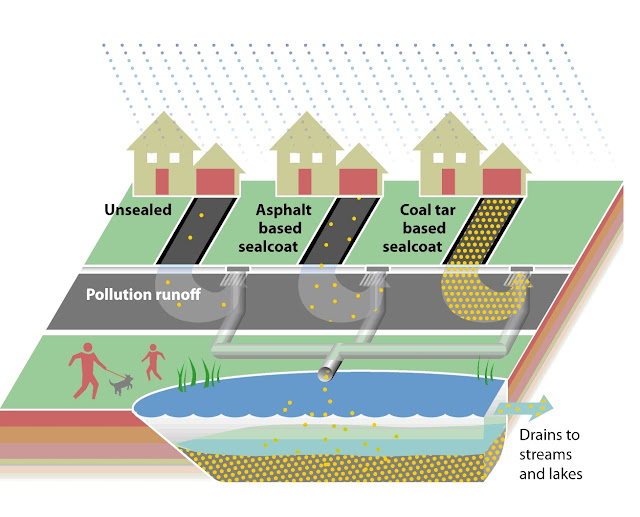Article from the Fall 2011 Estuary News of the Partnership for the Delaware Estuary
Ever cringe while watching a video from the ’50s of children being sprayed with DDT at a neighborhood pool? Maybe you were one of them! Or do you ever wonder, what were they thinking as doctors smoked in patients’ rooms in the ’60s? Ever feel that way when you or your neighbor seals a driveway? Do you feel a sense of foreboding for the environment and perhaps the children that may play on this surface? Most don’t—yet, but I do, and let me tell you why.
Most of the black liquid sprayed or mopped onto driveways and parking lots as pavement preservation or beautification is made from a material called “coal tar.” Coal tar is a waste product from the steel industry where purified coal (called “coke”) is used. Consequently, the most common kind of hazardous waste site in the United States is from coal tar. That fact prompted one headline from the Chicago Tribune: “Too Toxic for the Dump, But OK for Your Driveway.”
There are other parking-lot sealants on the market that are much less toxic, like asphalt, gilsonite or acrylic, but their use is far less common.: “Too Toxic for the Dump, But OK for Your Driveway.” There are other parking-lot sealants on the market that are much less toxic, like asphalt, gilsonite or acrylic, but their use is far less common.
 |
| Graphic Depicting Coal Tar Sealant Pollution from MN Pollution Control Agency |
PAHs are created from the incomplete combustion of organic material and can come from a variety of sources, but in much smaller concentrations. According to a 2005 study by the City of Austin, the concentration of coal tar sealant is dramatically higher than that which flakes off any other source. In fact, the flakes that come off a driveway are more than 1,000 times more toxic than the “effects concentration” of aquatic species. The effects concentration is the concentration which causes observable, adverse biological effects and reproduction problems in aquatic species.
The U.S. Geological Survey (USGS), an environmental science and research branch of the U.S.government, found that people living in ground-level apartments in Austin, Texas, where coal tar sealants are on the parking lot, are likely to have elevated PAH concentrations in the dust in their carpets. While there currently is no standard in the United States for PAH concentration in household dust, a German standard was exceeded in more than one in three apartments. PAHs have been documented to cause cancer, birth defects, learning disabilities, asthma, and decreased sperm counts in men. The lifetime cancer risk factor for coal tar sealant exposure has not yet been published, but soon it will be. [Editor’s note: Actually this was done by a toxicologist in a public meeting last week, see UConn PAH Seminar: Human Cancer Risks Federally “Unacceptable”]
Currently over 10 million U.S. citizens live in communities where coal tar sealants are banned. Home Depot and Lowes have stopped selling coal tar sealants in their stores. The Commonwealth of Massachusetts limits the use of coal tar sealants near wetlands. The State of Minnesota has ceased its use on state properties and projects. Statewide legislation has been introduced in a half-dozen states and was passed in 2010 in the State of Washington.
